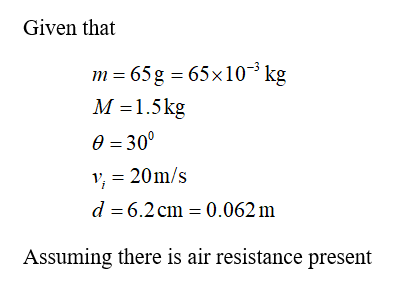can someone please do all sections of this question? show it step by step please and don't miss a part pleaseeee You get frustrated with your physics homework and you throw a blob of clay of mass m at a speed of vi at an angle of θ to the horizontal at your physics book of mass M that is sitting, sadly unread, on the floor. The clay sticks to the top of the book and the system slides a distance x along the floor before coming to a stop. a) State and justify whether or not linear momentum is conserved for the clay+book system i) in the x (horizontal) direction and ii) in the y (vertical) direction. (Hint: draw a sketch of the situation). b) Derive an expression for the coefficient of friction between the book and the floor in terms of the given quantities m, M vi,, θ, g, and x. c) Compute μk for m=65.0 g, M=1.50 kg, θ =30.0, vi = 20.0 m/s, d = 6.20 cm.
can someone please do all sections of this question? show it step by step please and don't miss a part pleaseeee
You get frustrated with your physics homework and you throw a blob of clay of mass m at a speed of vi at an angle of θ to the horizontal at your physics book of mass M that is sitting, sadly unread, on the floor. The clay sticks to the top of the book and the system slides a distance x along the floor before coming to a stop.
a) State and justify whether or not linear momentum is conserved for the clay+book system i) in the x (horizontal) direction and ii) in the y (vertical) direction. (Hint: draw a sketch of the situation).
b) Derive an expression for the coefficient of friction between the book and the floor in terms of the given quantities m, M vi,, θ, g, and x.
c) Compute μk for m=65.0 g, M=1.50 kg, θ =30.0, vi = 20.0 m/s, d = 6.20 cm.

Step by step
Solved in 2 steps with 3 images









